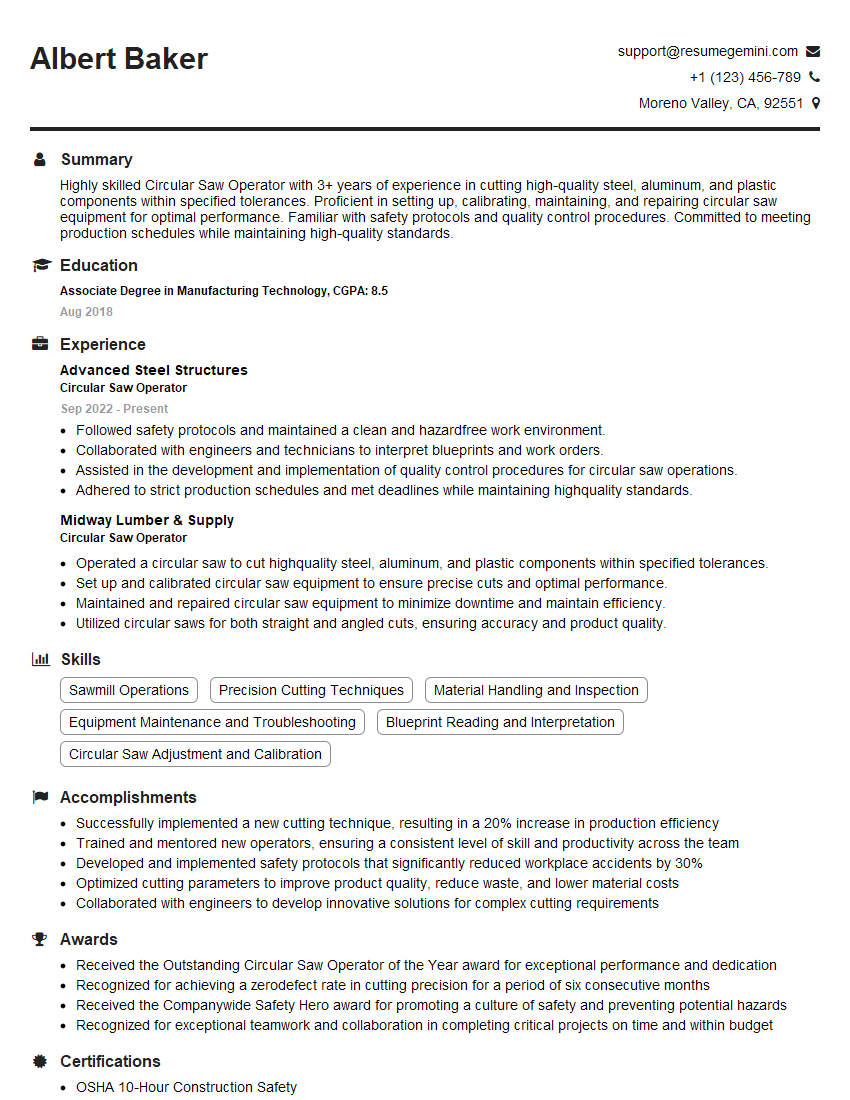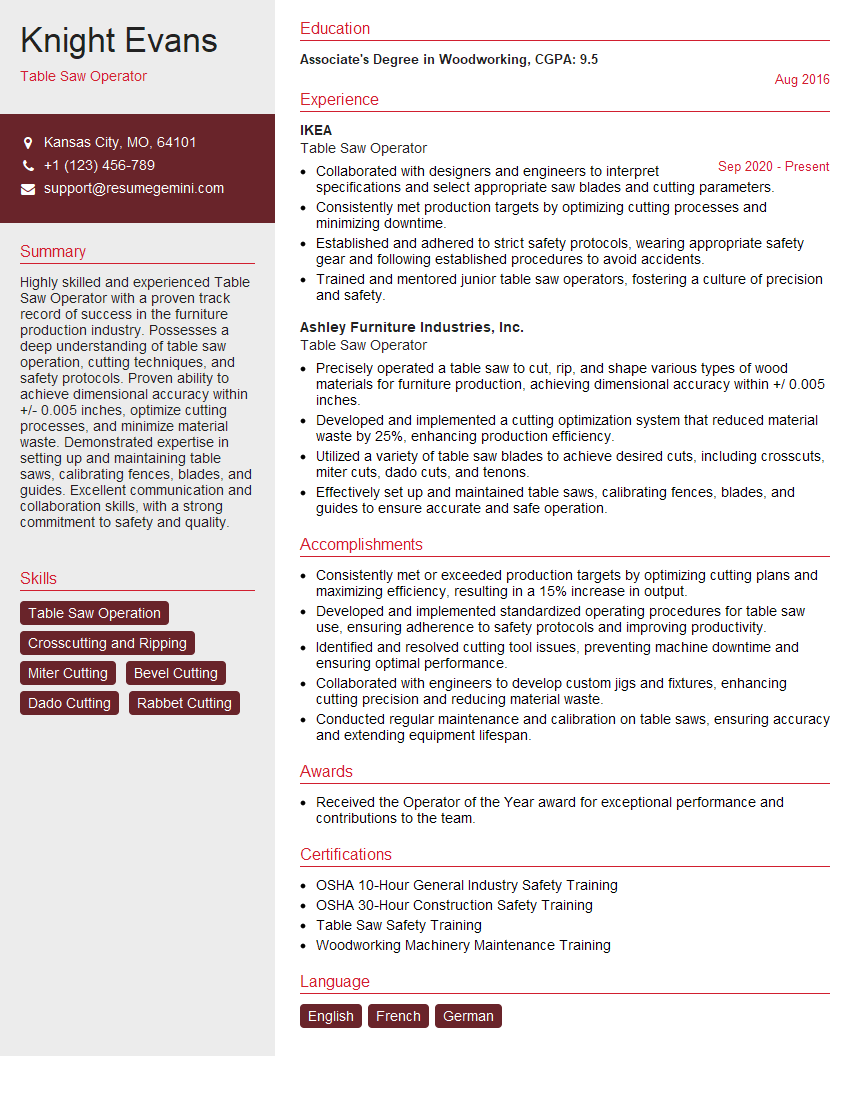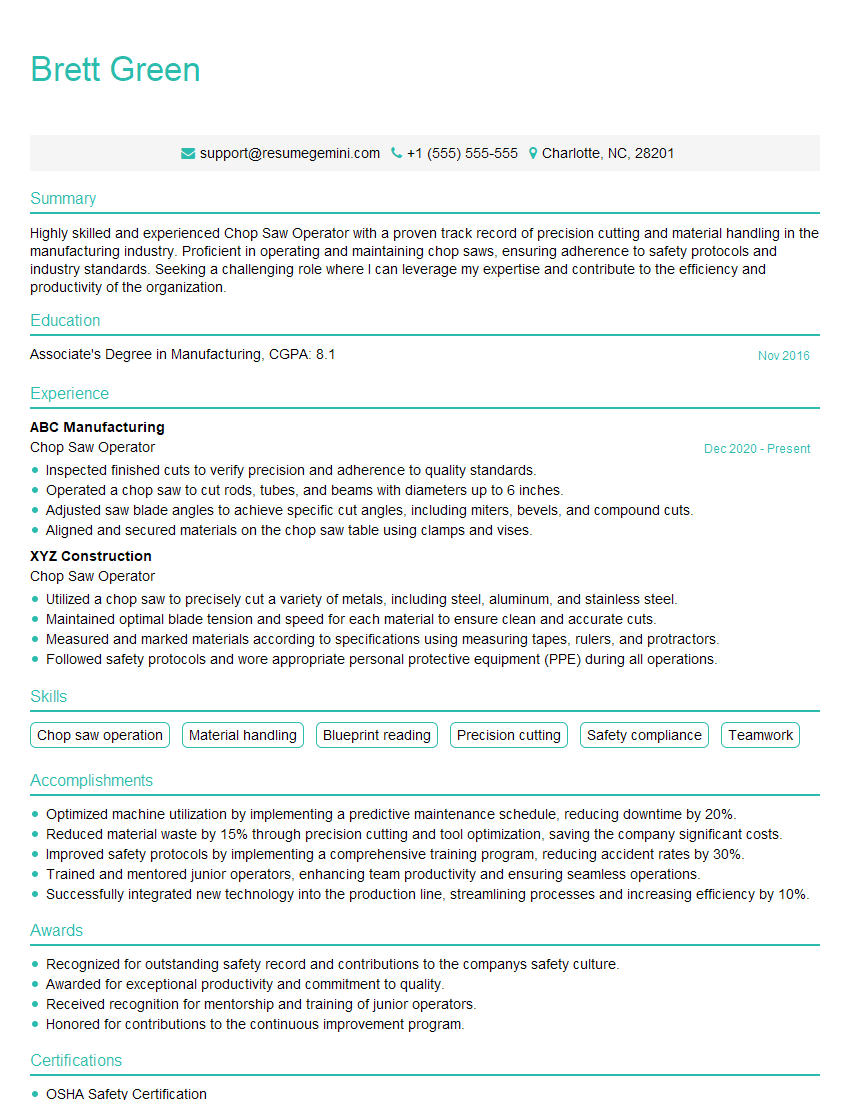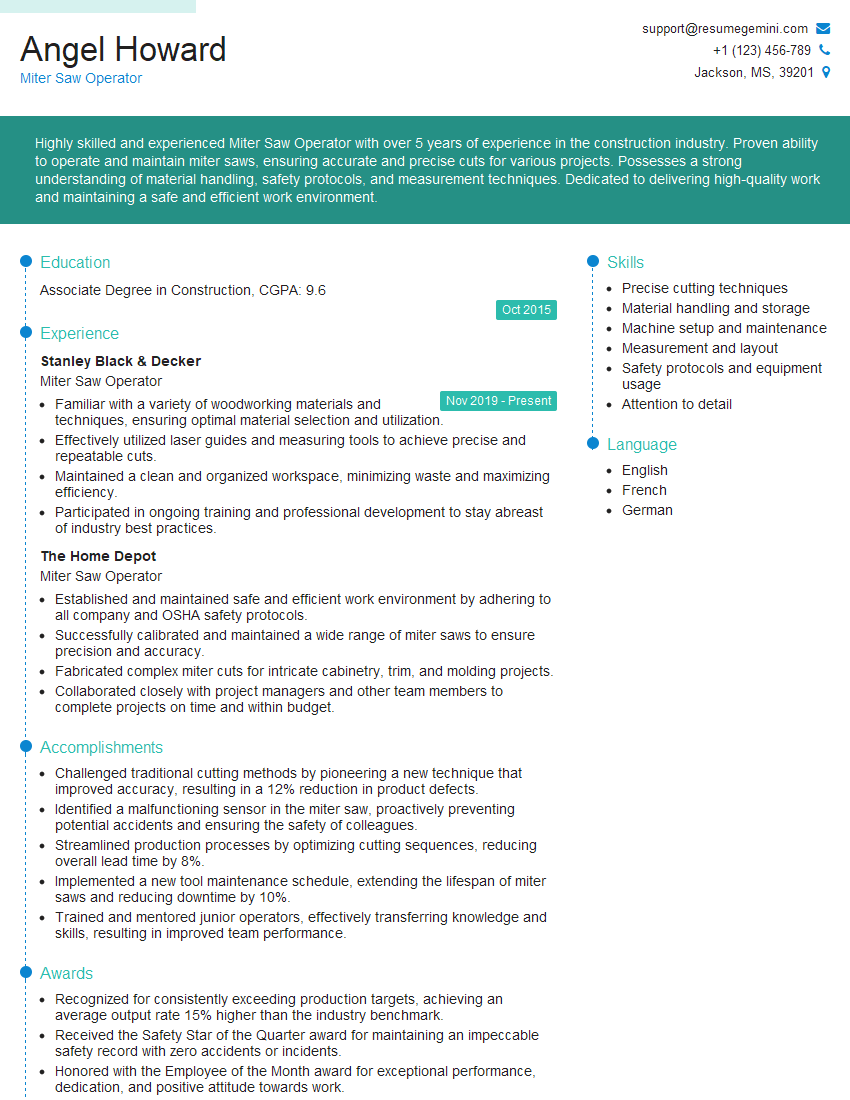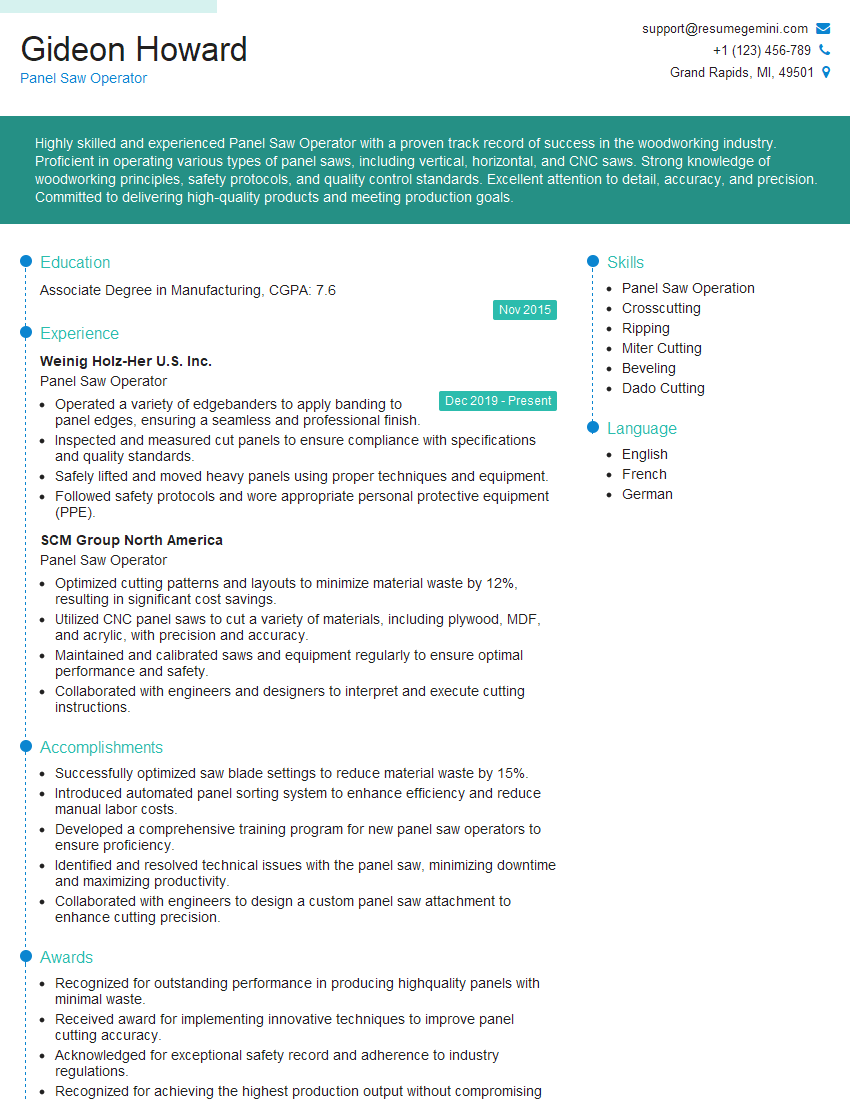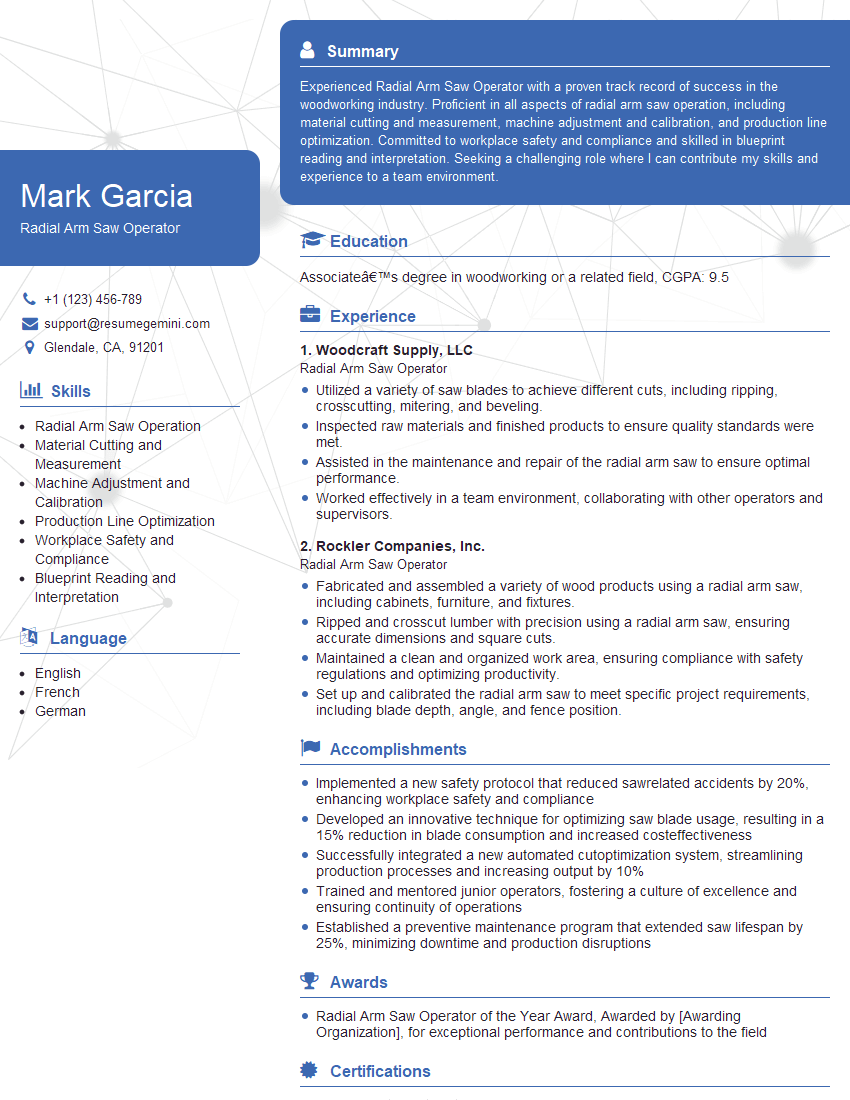Interviews are opportunities to demonstrate your expertise, and this guide is here to help you shine. Explore the essential Circular Saw Operations interview questions that employers frequently ask, paired with strategies for crafting responses that set you apart from the competition.
Questions Asked in Circular Saw Operations Interview
Q 1. Describe the different types of circular saw blades and their applications.
Circular saw blades come in a variety of types, each designed for specific materials and cutting applications. The key differences lie in tooth configuration, material, and blade size.
- General Purpose Blades: These are all-around blades with a moderate tooth count and design, suitable for cutting various softwoods, hardwoods, and plywood. Think of them as your everyday workhorse.
- Fine Tooth Blades: Featuring a higher tooth count, these blades produce smoother, cleaner cuts, ideal for finishing work or delicate materials like laminates or veneers. They are like a precision instrument for detail work.
- Crosscut Blades: Designed for cutting across the grain of wood, these blades have a special tooth configuration (often with a bevel) that minimizes tear-out and produces a cleaner cut. Imagine cutting boards perfectly square.
- Rip Blades: These blades are optimized for cutting with the grain of the wood, producing faster cuts with less friction. They are great for ripping long boards for framing.
- Combination Blades: These blades attempt to offer a compromise between crosscutting and ripping capabilities. While versatile, they won’t perform as well as specialized blades for either task.
- Metal Cutting Blades: With teeth designed for cutting metal, these blades require higher RPM and often have carbide tips for durability. These are a specialized category for a very different application.
Choosing the right blade is crucial for safety and a quality cut. Using the wrong blade can lead to poor results, damaged materials, and even injury.
Q 2. Explain the safety procedures for operating a circular saw.
Safety is paramount when operating a circular saw. Never rush the job. Here’s a checklist:
- Personal Protective Equipment (PPE): Always wear safety glasses or a face shield, hearing protection, work gloves, and appropriate footwear. Dust masks are recommended, especially when cutting dusty materials.
- Secure Workpiece: The material being cut must be firmly secured to prevent movement during the cut. Use clamps or a vise, ensuring stability.
- Proper Blade Selection: Use a blade appropriate for the material being cut. Using the wrong blade significantly increases the risk of kickback and injury.
- Body Positioning: Maintain a balanced stance, keeping your body clear of the blade’s path. Avoid reaching over the blade.
- Starting the Cut: Start the saw before contacting the material, and ease into the cut to avoid sudden jerking or binding.
- Finishing the Cut: Let the saw complete the cut before lifting it away from the material. Avoid forcing the blade through the material.
- Disconnecting Power: Always disconnect the power before making adjustments or changing the blade.
- Regular Inspection: Inspect the saw and blade for damage before each use. Replace or repair any worn or damaged components immediately.
Remember, a moment of carelessness can lead to serious injury. Prioritize safety above all else.
Q 3. How do you adjust the blade depth and bevel on a circular saw?
Adjusting the blade depth and bevel is essential for precise cuts. Most circular saws have easy-to-use adjustment mechanisms:
- Blade Depth: The depth of cut is adjusted using a depth adjustment lever or knob, typically located near the base of the saw. This allows you to control how deep the blade penetrates the material. For example, cutting a 1-inch thick board requires the blade to be set at least to 1 inch depth.
- Bevel Adjustment: The bevel is adjusted using a bevel adjustment knob or lever that tilts the blade to a specific angle. This allows for angled cuts, useful for things like miter joints or chamfers. The bevel scale usually shows the angle in degrees.
Always ensure the adjustment mechanisms are securely locked before starting the saw. Improper adjustment can lead to inaccurate cuts and possible injury.
Q 4. What are the common causes of kickback with a circular saw and how can they be prevented?
Kickback, the sudden forceful backward movement of the saw, is a serious hazard. It’s primarily caused by:
- Pinching or Binding: When the blade becomes pinched between the material and another object, or when the cut becomes bound, it can cause a sudden reaction that leads to kickback. This is often due to forcing the cut, using a dull blade, or not providing sufficient support to the workpiece.
- Contacting a foreign object: If the blade hits a nail, piece of metal, or other foreign object buried in the wood, it can also cause a rapid uncontrolled reaction resulting in kickback.
- Improper technique: Trying to cut at too aggressive of an angle can also lead to kickback, especially when the blade has to work harder to cut.
Prevention involves using a sharp blade, avoiding binding situations by applying sufficient pressure and proper support to the workpiece, carefully inspecting the material for foreign objects prior to cutting, and utilizing proper cutting techniques at all times.
Q 5. How do you maintain a circular saw blade to ensure optimal performance and safety?
Maintaining your circular saw blade is crucial for performance and safety. A dull or damaged blade increases the risk of kickback and produces poor-quality cuts.
- Cleaning: After each use, clean the blade thoroughly to remove sawdust and debris that can accumulate and interfere with its performance. A wire brush can be useful to clean the teeth.
- Inspection: Regularly inspect the blade for damage such as chipped or broken teeth, cracks or warping. Damaged blades should be replaced immediately.
- Sharpening: Sharpening can extend the life of a blade, but it’s a specialized process. If you’re not experienced in sharpening saw blades, it’s best to have a professional do it, or to replace the blade. Incorrect sharpening can make the blade dangerous.
- Storage: Store the blade in a safe place when not in use. This prevents accidental damage.
Remember, a well-maintained blade will not only deliver a cleaner and more efficient cut but will also greatly enhance safety during use.
Q 6. Explain the process of selecting the correct circular saw blade for a specific material.
Selecting the correct blade depends entirely on the material being cut and the desired outcome. Consider these factors:
- Material type: Different materials require different tooth designs. Softwoods need a different approach than hardwoods, and you certainly wouldn’t use a wood-cutting blade on metal.
- Cut type: Are you ripping (cutting with the grain), crosscutting (cutting against the grain), or doing a combination of both? Each cut type benefits from specific tooth geometry.
- Desired finish: Do you need a rough cut or a smooth, fine finish? Fine-tooth blades produce smoother cuts than coarser blades.
- Blade thickness: For thicker materials, you might need a thicker blade to prevent excessive vibration and ensure a straighter cut.
Always consult the blade’s specifications to ensure it’s appropriate for your material and application. Manufacturers provide this information to prevent misapplication and maintain safety.
Q 7. What are the signs of a dull or damaged circular saw blade?
A dull or damaged blade shows several signs that demand attention:
- Rough cuts: Dull blades produce ragged, uneven cuts, rather than smooth, clean ones. The material may show signs of tear-out or excessive splintering.
- Increased effort: It takes noticeably more effort to cut with a dull blade. You’ll feel a resistance and perhaps even the saw will slow down during the cut.
- Burning: A dull blade generates more friction, leading to overheating and scorching of the material. You may see burn marks on the wood or other material.
- Excessive vibration: A dull blade can cause the saw to vibrate excessively. This adds a fatigue factor to the operator and reduces accuracy.
- Chipped or broken teeth: Inspect the blade for any damage to the teeth. Even small chips can negatively impact performance and pose a safety hazard.
Never use a dull or damaged blade. It’s a safety hazard and will damage the material. Replace it with a fresh blade immediately.
Q 8. Describe the proper techniques for making various cuts (rip cuts, crosscuts, miter cuts).
Making accurate cuts with a circular saw depends on understanding the type of cut and using the correct technique. Let’s break down rip cuts, crosscuts, and miter cuts.
Rip Cuts: These are cuts made parallel to the wood grain. Imagine slicing a loaf of bread – that’s a rip cut. For a rip cut, position the saw’s base plate firmly against the edge of the wood, ensuring the blade is aligned with your cutting line. Use a push stick for added safety, especially on longer boards, to keep your hands clear of the blade.
Crosscuts: These cuts are perpendicular to the wood grain. Think cutting a slice of cake – that’s a crosscut. For accurate crosscuts, use a good quality square to mark your line precisely. Secure the wood firmly and make sure your saw blade is fully engaged before beginning the cut. Maintain steady, even pressure throughout.
Miter Cuts: These cuts are angled cuts, often used for joining pieces at an angle like picture frames. Miter saws are ideal, but a circular saw can handle this with a miter gauge attachment. This attachment ensures the saw blade is at the correct angle. Mark your angle carefully on the wood using a protractor or miter gauge, and be certain to clamp the wood firmly to avoid kickback. Remember, the more precise your measurements and setup, the cleaner your miter cut.
Q 9. How do you ensure accurate and precise cuts using a circular saw?
Achieving accurate and precise cuts with a circular saw involves several key steps. Firstly, precise marking is crucial. Use a sharp pencil and a reliable straight edge like a framing square or a metal ruler to mark your cutting line clearly. Next, proper setup is essential. Ensure your saw’s blade is sharp and the correct type for the material you’re cutting. A dull blade will lead to tear-out and inaccurate cuts.
Then comes the cutting technique. Use a firm grip on the saw, but avoid applying excessive pressure, which can cause the saw to bind or wander off the line. Maintain a consistent cutting speed and let the saw do the work. The use of clamping devices is incredibly important, especially for larger or unstable pieces of wood. Clamping secures the workpiece and reduces the chance of the material moving during the cut.
Finally, it’s important to consider the depth of cut. Make sure the blade’s depth is set correctly, avoiding cutting all the way through the workpiece unless intended, which prevents dangerous kickback and ensures the precision of your cut. Regular maintenance of your saw, including blade cleaning and sharpening, will enhance accuracy over time. Imagine trying to cut a straight line with a dull knife – it’s just not going to work well!
Q 10. What are the different types of circular saws and their uses?
Circular saws come in a variety of types, each designed for specific applications. The most common include:
- Worm-Drive Circular Saw: Known for its powerful motor and ability to handle tough cuts, often preferred for demolition work and cutting thicker materials. The worm-drive design also provides better control in challenging cutting scenarios.
- Side-Winding Circular Saw: Lighter and more compact than worm-drive models. They’re a good choice for lighter-duty applications like cutting smaller pieces of wood and trimming.
- Portable Circular Saw (also called a Skilsaw): This is the standard circular saw used in most DIY and many professional settings. Its versatility makes it a staple in woodworking shops and job sites.
- Handheld Circular Saw: Smaller, lighter, and often cordless, making them ideal for smaller projects and tight spaces. Their portability is a major advantage.
The choice of saw depends on the task. For example, a powerful worm-drive saw is needed for framing a house, while a smaller handheld saw may suffice for cutting smaller pieces of molding.
Q 11. What safety equipment is essential when operating a circular saw?
Safety should always be paramount when operating a circular saw. Essential safety equipment includes:
- Eye protection: Safety glasses or a face shield are crucial to prevent flying debris from injuring your eyes. This is non-negotiable.
- Hearing protection: Circular saws are noisy. Earplugs or earmuffs are essential to protect your hearing from long-term damage.
- Dust mask or respirator: Wood dust can be harmful if inhaled. A dust mask or respirator protects your lungs, especially when cutting hardwoods or treated lumber.
- Work gloves: These protect your hands from cuts and splinters. Choose gloves that offer good dexterity and aren’t bulky enough to hinder your ability to control the saw.
- Proper clothing: Wear close-fitting clothing, avoiding loose sleeves or dangling jewelry that could get caught in the blade. Sturdy work boots are also essential to protect your feet.
Furthermore, ensure the work area is well-lit and clear of obstructions. Always use the appropriate blade for the material and ensure that the saw is in good working order before beginning any operation.
Q 12. How do you handle different types of wood while using a circular saw?
Handling different types of wood requires adjustments in technique and equipment. Hardwoods like oak and maple are denser and harder to cut than softwoods like pine or fir. For hardwoods, use a sharper blade with more teeth for a cleaner cut and to minimize the risk of binding. You might also need to reduce your cutting speed slightly to avoid overloading the motor.
Softwoods are easier to cut, but the risk of tear-out is higher. Using a blade with fewer teeth and a higher tooth profile can help prevent this. Always consider the grain direction of the wood, cutting with the grain whenever possible to avoid splintering or kickback. Treated lumber often requires a dedicated blade designed to handle the specific chemicals used in the treatment process. Improper blades can quickly dull and potentially become hazardous.
Q 13. What are the potential hazards associated with circular saw operation?
Circular saws, while incredibly useful, present several potential hazards:
- Kickback: This is a sudden, forceful recoil of the saw, often caused by pinching the blade, improper blade alignment, or cutting into a knot in the wood. Kickback can result in serious injury.
- Blade contact: Accidental contact with the spinning blade can cause severe cuts. Always maintain a safe distance from the blade during operation.
- Dust inhalation: Wood dust, especially from hardwoods or treated lumber, can be harmful to your respiratory system. Always wear a dust mask or respirator.
- Hearing loss: Prolonged exposure to the noise of a circular saw can lead to hearing loss. Use hearing protection.
- Electric shock: With corded saws, there’s a risk of electric shock if the cord is damaged or comes into contact with water.
By following proper safety procedures and using appropriate safety equipment, these risks can be significantly reduced.
Q 14. How do you troubleshoot common circular saw problems?
Troubleshooting common circular saw problems often involves simple checks and maintenance:
- Saw won’t start: Check the power cord connection, the power switch, and the battery (if cordless) for proper function. Also check the circuit breaker or extension cord.
- Blade binding or stalling: This often indicates that the blade is dull, the depth of cut is too deep, or the material is too hard for the blade. Sharpen the blade or use a more appropriate one. Always make sure the depth of cut is correct for the material.
- Inaccurate cuts: Check that the blade is sharp, the fence or miter gauge is aligned correctly, and the saw base is securely attached and level. The cutting line should be marked accurately.
- Excessive vibration: This could point to a loose blade, worn bearings, or damage to the saw housing. Inspect the saw for any loose parts and seek professional repair if necessary.
- Saw is overheating: This may be due to an overload, a dull blade, or insufficient ventilation. Allow the saw to cool down before continuing, replace the blade if necessary, and never force the saw beyond its capabilities.
Regular maintenance, including cleaning, blade sharpening, and lubrication, is key to preventing many common problems and ensuring your saw’s longevity. Remember to consult your saw’s manual for specific troubleshooting instructions.
Q 15. What are the procedures for cleaning and maintaining a circular saw?
Cleaning and maintaining a circular saw is crucial for its longevity and safe operation. Think of it like regular car maintenance – neglecting it leads to problems down the line.
- Blade Cleaning: After each use, carefully brush off sawdust and debris from the blade using a wire brush or compressed air. Never touch the blade’s teeth directly without proper safety gear.
- Body Cleaning: Wipe down the saw’s body with a damp cloth to remove any dust or resin buildup. Avoid using harsh chemicals that could damage the saw’s housing or electrical components.
- Lubrication: Check the saw’s manual for lubrication points, often located on the arbor bearings. Apply a few drops of appropriate lubricant as recommended to reduce friction and prolong the saw’s life.
- Checking for Damage: Inspect the blade for any cracks, chips, or excessive wear. Inspect the base plate for damage and ensure the shoe is flat and not bent. Also, check the blade’s alignment, which is critical.
- Storage: When not in use, store the saw in a dry, secure place away from children. Always cover the blade appropriately to prevent accidental injury.
Regular cleaning and maintenance will prevent premature wear and ensure your circular saw performs optimally and safely.
Career Expert Tips:
- Ace those interviews! Prepare effectively by reviewing the Top 50 Most Common Interview Questions on ResumeGemini.
- Navigate your job search with confidence! Explore a wide range of Career Tips on ResumeGemini. Learn about common challenges and recommendations to overcome them.
- Craft the perfect resume! Master the Art of Resume Writing with ResumeGemini’s guide. Showcase your unique qualifications and achievements effectively.
- Don’t miss out on holiday savings! Build your dream resume with ResumeGemini’s ATS optimized templates.
Q 16. Explain the importance of blade alignment and its impact on cutting accuracy.
Blade alignment is paramount for accurate cuts. Imagine trying to cut a straight line with a knife whose blade is crooked – the result would be uneven and inaccurate.
An improperly aligned blade will cause the saw to wander, leading to inaccurate cuts, potentially damaging the workpiece and creating safety hazards. A misaligned blade puts extra stress on the motor and bearings, shortening the saw’s lifespan. A properly aligned blade ensures the teeth engage the material consistently, resulting in clean, straight cuts.
To check alignment, observe the blade from the side while the saw is running at low speed. The blade should rotate true, without any noticeable wobble or deviation from a straight line. Most circular saws have adjustment mechanisms to correct blade alignment; consult the saw’s manual for detailed instructions.
Q 17. Describe your experience with different types of circular saw guards and their functionality.
Circular saw guards are essential safety devices, preventing accidental contact with the spinning blade. Different guards offer varying levels of protection depending on the application.
- Upper Blade Guard: This is the most common type, automatically covering the blade when not cutting. It retracts as the saw is plunged into the workpiece and covers the blade during non-cutting phases. This guard minimizes kickback risk and protects the operator from accidental contact.
- Lower Blade Guard (Riving Knife): Often used in table saws, a riving knife is positioned behind the blade to prevent the material from pinching the blade, which could cause kickback or binding.
- Splitter: Similar in function to the riving knife, a splitter helps keep the cut open and prevents kickback. Usually found on larger and more robust saws.
- Anti-Kickback Paws: These are small, sometimes retractable, projections near the blade, designed to prevent the material from being thrown back towards the operator.
The choice of guard depends on the type of circular saw and the nature of the work. Always ensure the guard is in good working order and correctly fitted before operating the saw.
Q 18. How do you handle different materials such as hardwoods, softwoods, and composite materials?
Handling different materials requires adjusting cutting techniques and blade selection. Imagine using a butter knife to cut a steak – you’d need a different tool for the job.
- Hardwoods (Oak, Maple): Require sharp blades with a high tooth count for cleaner cuts and reduced risk of chipping. Slower feed rates are also often necessary.
- Softwoods (Pine, Fir): Can be cut more aggressively with fewer teeth but sharp blades are still important to prevent tearout.
- Composite Materials (Plywood, MDF): Can be prone to burning or chipping, especially if the blade is dull or if the feed rate is too slow. A sharp blade with fine teeth and a moderate feed rate generally work well. Using a higher tooth count blade can help produce cleaner cuts.
In each case, maintaining a sharp blade is crucial for preventing damage to both the material and the saw. Remember always to adjust your cutting speed and technique according to the specific material and blade type.
Q 19. What are the regulations and safety standards related to circular saw operation in your region?
(Note: Safety regulations vary by region. This answer provides a general overview. Consult your local authorities and relevant safety standards for specific requirements.)
Regulations concerning circular saw operation typically emphasize safety precautions including proper training, use of personal protective equipment (PPE – eye protection, hearing protection, dust mask, gloves), machine guarding, safe work practices, and emergency procedures. Specific regulations may cover aspects like machine inspection, operator competency requirements, workplace risk assessments and the safe handling, storage and transportation of blades. Failure to comply with these regulations can lead to fines or even legal action.
Always prioritize safety and consult your local regulations for specifics related to circular saw operation in your region. The information provided is for educational purposes and should not be substituted for professional safety training and compliance with local regulations.
Q 20. Describe your experience with different types of circular saw stands and their applications.
Circular saw stands provide stability and accuracy, especially when making repetitive cuts or working with large pieces of material. Think of them as providing a steady base, like a tripod for a camera.
- Simple Stands: These offer basic support for the saw, improving stability compared to hand-held operation.
- Miter Saw Stands: Allow for accurate angle cuts and are commonly used for mitering. They’re often adjustable and accommodate different saw sizes.
- Heavy-Duty Stands: Built for more robust applications, these stands provide superior stability and can support heavier saws and workpieces.
- Rolling Stands: Offer portability and easy movement during larger projects or when working in multiple locations.
The choice of saw stand depends on the project’s requirements and the size and weight of the saw. A stable stand is crucial for precise cuts and safe operation.
Q 21. How do you ensure the safe handling and storage of circular saw blades?
Safe handling and storage of circular saw blades is vital to prevent injury and damage. Treating them carelessly is like playing with a loaded weapon.
- Transportation: Always transport blades in a protective case or container. Never carry them loose in a vehicle or toolbox.
- Handling: When handling a blade, always wear appropriate gloves to avoid cuts. Never attempt to catch a falling blade.
- Storage: Store blades in a dry, secure place, out of reach of children. Use blade storage cases or racks designed for that purpose, ideally clearly labeled for size and type.
- Disposal: Dispose of dull or damaged blades appropriately, usually via designated recycling programs for metal waste.
Adhering to these practices minimizes risks and ensures the longevity of your blades. Remember that carelessness can have serious consequences.
Q 22. Explain the process of changing a circular saw blade.
Changing a circular saw blade is a crucial safety procedure. Before you begin, always disconnect the power source – this is paramount! Next, you’ll need to loosen the blade retaining mechanism, which typically involves a locking nut or spindle lock. The exact method varies depending on the saw model, so always consult your saw’s manual. Once loosened, carefully remove the old blade, ensuring you wear appropriate safety gloves to protect your hands from sharp edges. When installing the new blade, make sure it’s the correct type and size for your saw, and that the teeth are facing the correct direction (usually indicated by an arrow on the blade itself). Tighten the retaining mechanism firmly, but avoid over-tightening. Finally, carefully inspect the blade to ensure it’s properly secured before plugging in the saw and resuming work. Think of it like changing a tire – a methodical approach minimizes the risk of injury.
Q 23. Describe your experience with using different types of power sources for circular saws.
I’ve extensive experience with both corded and cordless circular saws. Corded saws, powered by mains electricity, offer consistent power and are ideal for heavy-duty, prolonged cutting tasks. However, they limit mobility due to the power cord. Cordless saws, powered by rechargeable batteries, offer significant advantages in terms of portability and maneuverability, making them excellent for jobs where cord management is a concern, such as working on ladders or in tight spaces. However, battery life and power output can be limiting factors, particularly for demanding cuts through hard materials. The choice depends heavily on the specific job; for example, I’d choose a corded saw for a large framing project but a cordless saw for trimming baseboards in a finished room.
Q 24. How do you deal with unexpected situations or emergencies while using a circular saw?
Safety is my top priority. Unexpected situations, like blade binding or kickback, require immediate action. If the blade binds, I immediately release the trigger and gently try to ease the pressure, never forcing the saw. If kickback occurs – which is the blade suddenly rising up – I instinctively release the trigger, maintain a firm grip, and allow the saw to come to a complete stop before addressing the issue. Knowing how to properly control the saw and anticipate potential problems is key. If a problem arises that I can’t resolve immediately, I immediately shut down the saw, secure the area, and address the issue carefully, potentially seeking assistance if needed. Remember, it’s always better to err on the side of caution.
Q 25. What are the best practices for optimizing cutting speed and efficiency?
Optimizing cutting speed and efficiency involves several key factors. First, choose the right blade for the material; a fine-toothed blade is better for intricate cuts in softer woods, while a coarse-toothed blade works better for rough cuts in harder materials. Second, maintaining a consistent feed rate is crucial; pushing too hard can lead to binding and damage. Third, ensure the saw is properly maintained; a dull blade significantly reduces cutting speed and efficiency. Finally, using appropriate cutting guides or jigs can dramatically increase both accuracy and speed by ensuring straight, consistent cuts. It’s like cooking – the right tools and techniques make the process faster and produce a better result.
Q 26. Describe your experience with using different types of cutting guides and jigs.
My experience includes using various cutting guides and jigs, such as straight edges, miter boxes, and various types of clamps and fences. Straight edges provide accurate guidance for straight cuts, while miter boxes allow for precise angled cuts. Clamps are essential for securing workpieces, ensuring accurate and safe cutting. Jigs, specifically designed for repetitive cuts, are invaluable for enhancing speed and consistency. For instance, when making multiple identical cuts, a jig ensures perfect replication, saving both time and effort. Properly using these tools drastically minimizes errors and increases overall precision.
Q 27. How would you train a new employee on the safe operation of a circular saw?
Training a new employee on circular saw operation begins with a thorough safety briefing, emphasizing the importance of personal protective equipment (PPE) – safety glasses, hearing protection, and appropriate clothing. Hands-on demonstrations of proper techniques, including starting and stopping, cutting methods, and how to avoid common hazards are crucial. I’d start with simple cuts on scrap material, gradually increasing complexity. We’d then discuss troubleshooting and emergency procedures, and finally, I’d supervise the new employee while they perform cuts under real-world conditions. Consistent monitoring and reinforcement of safe practices are vital to preventing accidents.
Q 28. Describe a situation where you had to troubleshoot a problem with a circular saw. How did you resolve it?
Once, while cutting a thick piece of hardwood, I experienced significant vibration and a noticeable decrease in cutting speed. I suspected a dull blade, but I first checked the saw’s alignment and ensured the blade was properly tightened. Upon inspecting the blade, I indeed found that it was significantly dulled, requiring replacement. After installing a new, sharp blade, the problem was resolved immediately. The saw operated smoothly, and the cutting speed returned to normal. This reinforced the importance of regular blade inspection and replacement for optimal performance and safety. Ignoring the subtle signs could have led to more significant issues and potential injury.
Key Topics to Learn for Circular Saw Operations Interview
- Saw Blade Selection and Maintenance: Understanding different blade types (e.g., carbide-tipped, diamond), their applications, proper sharpening techniques, and recognizing signs of wear and tear.
- Safe Operating Procedures: Practical application of safety regulations, including proper machine setup, personal protective equipment (PPE) usage, emergency shutdown procedures, and lockout/tagout protocols.
- Material Handling and Feed Rates: Understanding the properties of various materials (wood, metal, etc.) and how they affect cutting speed, feed rate adjustments, and preventing material binding or kickback.
- Troubleshooting and Maintenance: Diagnosing common operational problems (e.g., blade deflection, vibration, inaccurate cuts), performing routine maintenance tasks, and understanding preventative maintenance schedules.
- Quality Control and Measurement: Ensuring consistent cut quality through accurate measurements, understanding tolerance levels, and identifying defects. This includes using measuring tools and understanding dimensional accuracy.
- Circular Saw Types and Applications: Familiarity with various circular saw types (portable, benchtop, radial arm) and their respective applications in different industries.
- Health and Safety Regulations: Demonstrating a thorough understanding of relevant health and safety regulations concerning circular saw operation and workplace safety.
Next Steps
Mastering Circular Saw Operations opens doors to rewarding careers in manufacturing, construction, and woodworking, offering opportunities for advancement and specialized skills development. To maximize your job prospects, it’s crucial to present your expertise effectively. Crafting an ATS-friendly resume is key to getting your application noticed by recruiters and hiring managers. ResumeGemini is a trusted resource that can help you build a professional and impactful resume, ensuring your qualifications shine. Examples of resumes tailored specifically to Circular Saw Operations are available to help guide you.
Explore more articles
Users Rating of Our Blogs
Share Your Experience
We value your feedback! Please rate our content and share your thoughts (optional).
What Readers Say About Our Blog
Hi, I’m Jay, we have a few potential clients that are interested in your services, thought you might be a good fit. I’d love to talk about the details, when do you have time to talk?
Best,
Jay
Founder | CEO
